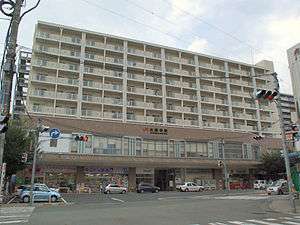Suizenji Station
Suizenji Station (水前寺駅, Suizenji-eki) is a railway station on the Hohi Main Line operated by JR Kyushu in Chūō-ku, Kumamoto, Japan.[1][2]
Suizenji Station 水前寺駅 | |
|---|---|
 Suizenji Station in 2006 | |
| Location | Japan |
| Coordinates | 32°47′50″N 130°43′49″E |
| Operated by | |
| Line(s) | ■ Hōhi Main Line |
| Distance | 5.8 km from Kumamoto |
| Platforms | 1 island platform |
| Tracks | 2 |
| Construction | |
| Disabled access | Yes - elevator to station and platform |
| Other information | |
| Status | Staffed ticket window (Midori no Madoguchi)(outsourced) |
| Website | Official website |
| History | |
| Opened | 21 June 1914 |
| Traffic | |
| Passengers (FY2016) | 3,168 daily |
| Rank | 58th (among JR Kyushu stations) |
| Location | |
 Suizenji Station Location within Japan | |
Lines
The station is served by the Hōhi Main Line and is located 5.8 km from the starting point of the line at Kumamoto.[3]
Layout
The station consists of an island platform serving two tracks at grade. The station building is integrated within a modern multi-storey building with many shops and commercial tenants as well as apartments on the upper floors. The station itself is located on level 2 and includes an enclosed waiting room and a staffed ticket window. A passageway leads to a flight of steps which connects to the island platform. The same passageway also serves to connect to a second entrance to the station serving the street on the other side of the tracks. There is also elevator access to the station from street level and from the station to the platform.[2][3][4]
Management of the station has been outsourced to the JR Kyushu Tetsudou Eigyou Co., a wholly owned subsidiary of JR Kyushu specialising in station services. It staffs the ticket booth which is equipped with a Midori no Madoguchi facility.[5][6]
 A view of the station platform and tracks. Note the passageway in the distance which leads to the second station entrance.
A view of the station platform and tracks. Note the passageway in the distance which leads to the second station entrance. The second station entrance, on the north side of the tracks.
The second station entrance, on the north side of the tracks.
History
On 21 June 1914, Japanese Government Railways (JGR) opened the Miyagi Light Rail Line (宮地軽便線) (later the Miyagi Line) from Kumamoto eastwards to Higo-Ōzu. On the same day, this station was opened as one of several intermediate stations along the track. By 1928, the track had been extended eastward and had linked up with the Inukai Line (犬飼線) which had been built westward from Ōita. On 2 December 1928, the entire track from Kumamoto to Ōita was designated as the Hōhi Main Line. With the privatization of Japanese National Railways (JNR), the successor of JGR, on 1 April 1987, the station came under the control of JR Kyushu.[7][8]
Passenger statistics
In fiscal 2016, the station was used by an average of 3,168 passengers daily (boarding passengers only), and it ranked 58th among the busiest stations of JR Kyushu.[9]
Environs
See also
References
- "JR Kyushu Route Map" (PDF). JR Kyushu. Retrieved 23 February 2018.
- "水前寺" [Suizenji]. hacchi-no-he.net. Retrieved 28 April 2018.
- Kawashima, Ryōzō (2013). 図説: 日本の鉄道 四国・九州ライン 全線・全駅・全配線・第6巻 熊本 大分 エリア [Japan Railways Illustrated. Shikoku and Kyushu. All lines, all stations, all track layouts. Volume 6 Kumamoto Ōita Area] (in Japanese). Kodansha. pp. 34, 77. ISBN 9784062951654.
- "水前寺" [Suizenji]. Retrieved 28 April 2018. Blog entry with good photographic coverage of station facilities.
- "熊本支店内各駅" [Stations within the Kumamoto Branch]. JRTE website. Retrieved 18 April 2018.
- "水前寺駅" [Suizenji Station]. jr-mars.dyndns.org. Retrieved 28 April 2018. See images of tickets sold.
- Ishino, Tetsu; et al., eds. (1998). 停車場変遷大事典 国鉄・JR編 [Station Transition Directory - JNR/JR] (in Japanese). I. Tokyo: JTB Corporation. p. 228. ISBN 4533029809.
- Ishino, Tetsu; et al., eds. (1998). 停車場変遷大事典 国鉄・JR編 [Station Transition Directory - JNR/JR] (in Japanese). II. Tokyo: JTB Corporation. pp. 743–4. ISBN 4533029809.
- "駅別乗車人員上位300駅(平成28年度)" [Passengers embarking by station - Top 300 stations (Fiscal 2016)] (PDF). JR Kyushu. 31 July 2017. Retrieved 25 February 2018.
| Wikimedia Commons has media related to Suizenji Station. |